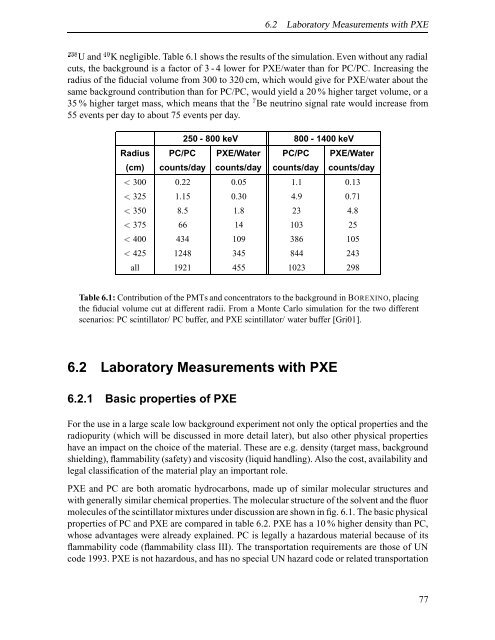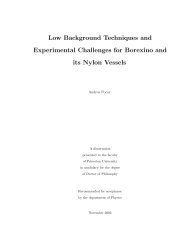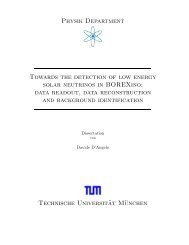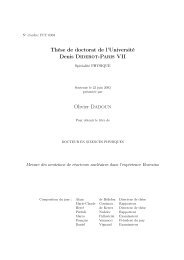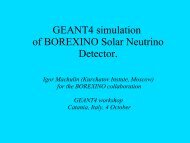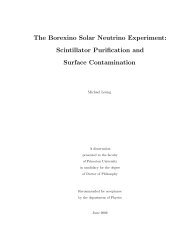Development of a Liquid Scintillator and of Data ... - Borexino - Infn
Development of a Liquid Scintillator and of Data ... - Borexino - Infn
Development of a Liquid Scintillator and of Data ... - Borexino - Infn
You also want an ePaper? Increase the reach of your titles
YUMPU automatically turns print PDFs into web optimized ePapers that Google loves.
6.2 Laboratory Measurements with PXE<br />
U <strong>and</strong> K negligible. Table 6.1 shows the results <strong>of</strong> the simulation. Even without any radial<br />
cuts, the background is a factor <strong>of</strong> 3 - 4 lower for PXE/water than for PC/PC. Increasing the<br />
radius <strong>of</strong> the fiducial volume from 300 to 320 cm, which would give for PXE/water about the<br />
same background contribution than for PC/PC, would yield a 20 % higher target volume, or a<br />
35 % higher target mass, which means that the Be neutrino signal rate would increase from<br />
55 events per day to about 75 events per day.<br />
250 - 800 keV 800 - 1400 keV<br />
Radius PC/PC PXE/Water PC/PC PXE/Water<br />
(cm) counts/day counts/day counts/day counts/day<br />
300 0.22 0.05 1.1 0.13<br />
325 1.15 0.30 4.9 0.71<br />
350 8.5 1.8 23 4.8<br />
375 66 14 103 25<br />
400 434 109 386 105<br />
425 1248 345 844 243<br />
all 1921 455 1023 298<br />
Table 6.1: Contribution <strong>of</strong> the PMTs <strong>and</strong> concentrators to the background in BOREXINO, placing<br />
the fiducial volume cut at different radii. From a Monte Carlo simulation for the two different<br />
scenarios: PC scintillator/ PC buffer, <strong>and</strong> PXE scintillator/ water buffer [Gri01].<br />
6.2 Laboratory Measurements with PXE<br />
6.2.1 Basic properties <strong>of</strong> PXE<br />
For the use in a large scale low background experiment not only the optical properties <strong>and</strong> the<br />
radiopurity (which will be discussed in more detail later), but also other physical properties<br />
have an impact on the choice <strong>of</strong> the material. These are e.g. density (target mass, background<br />
shielding), flammability (safety) <strong>and</strong> viscosity (liquid h<strong>and</strong>ling). Also the cost, availability <strong>and</strong><br />
legal classification <strong>of</strong> the material play an important role.<br />
PXE <strong>and</strong> PC are both aromatic hydrocarbons, made up <strong>of</strong> similar molecular structures <strong>and</strong><br />
with generally similar chemical properties. The molecular structure <strong>of</strong> the solvent <strong>and</strong> the fluor<br />
molecules <strong>of</strong> the scintillator mixtures under discussion are shown in fig. 6.1. The basic physical<br />
properties <strong>of</strong> PC <strong>and</strong> PXE are compared in table 6.2. PXE has a 10 % higher density than PC,<br />
whose advantages were already explained. PC is legally a hazardous material because <strong>of</strong> its<br />
flammability code (flammability class III). The transportation requirements are those <strong>of</strong> UN<br />
code 1993. PXE is not hazardous, <strong>and</strong> has no special UN hazard code or related transportation<br />
77


